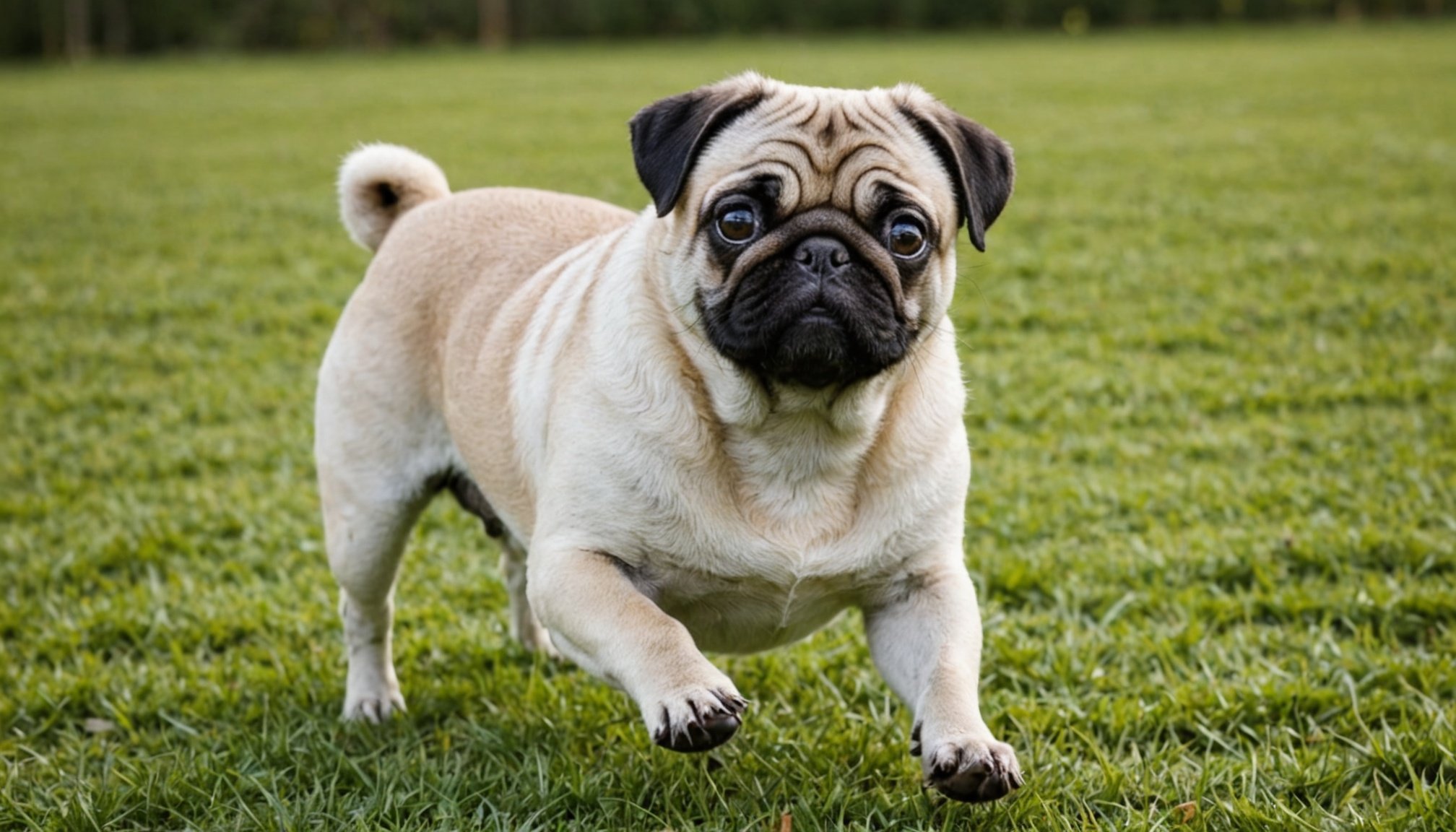Top Training Treats That Will Motivate Even the Stubbornest Pugs!
Understanding the Pug Personality
When it comes to training a pug, it’s essential to understand their unique personality and needs. Pugs are known for their affectionate and playful nature, but they can also be quite stubborn at times. This stubbornness is often a result of their independent streak and the fact that they can be very treat-motivated[2].
“Pugs are very treat motivated and can easily learn tricks / commands,” notes an article on Wag Walking. However, this treat motivation can be both a blessing and a curse. On one hand, it makes them highly responsive to positive reinforcement training. On the other hand, it means you need to choose the right treats to keep them engaged and motivated.
Also read : Key Attributes of a Premium Cat Travel Carrier: Essential Features You Can”t Overlook!
The Importance of Positive Reinforcement
Positive reinforcement is a cornerstone of effective dog training, especially for stubborn breeds like pugs. This method involves rewarding good behavior with treats, praise, or other positive outcomes. Here’s why it works so well:
- Encourages Good Behavior: By rewarding desired behaviors, you reinforce what you want your pug to do more often.
- Builds Trust: Positive reinforcement helps build a strong bond between you and your dog, making the training process more enjoyable and effective.
- Reduces Stress: Unlike punitive methods, positive reinforcement is gentle and stress-free, which is crucial for sensitive breeds like pugs[3].
Choosing the Right Training Treats
The type of treat you use can significantly impact the success of your training sessions. Here are some key factors to consider when selecting training treats for your pug:
Also to see : Top Tips for Whipping Up Allergy-Friendly Homemade Dog Food: A Guide for Caring Pet Owners
Texture and Flavor
Pugs tend to prefer soft, chewy treats over hard, crunchy ones. These textures are more appealing and easier for them to chew, given their brachycephalic (flat-faced) anatomy and potential eating difficulties[4].
High Value Treats
High-value treats are those that your pug finds particularly enticing. These could be freeze-dried chicken breast, lamb, or beef treats. High-value treats are especially useful during the initial stages of training when you need to capture your pug’s attention and motivate them to learn.
Healthy Ingredients
Ensure that the treats you choose are made from healthy, wholesome ingredients. Pugs can be prone to various health issues, so it’s crucial to avoid treats with fillers, artificial preservatives, or other unhealthy additives.
Top Training Treats for Pugs
Here are some top training treats that are highly effective for motivating pugs:
-
Pupford Freeze Dried Chicken Breast Treats:
-
Made from real chicken breast with no added preservatives.
-
Freeze-dried to retain the natural texture and flavor.
-
High motivation treat that doesn’t get greasy or grimy[1].
-
Sweet Potato Chews:
-
Soft and chewy, making them easy for pugs to digest.
-
Rich in fiber and vitamins.
-
Often considered a healthier alternative to traditional dog treats.
-
Lamb or Beef Jerky Strips:
-
High in protein and low in fat.
-
Soft and chewy texture that pugs love.
-
Can be cut into smaller pieces for training sessions.
How to Use Training Treats Effectively
Using training treats effectively requires a combination of patience, consistency, and the right techniques. Here are some tips to help you get the most out of your training sessions:
Short Training Sessions
Pugs have short attention spans, so it’s best to keep training sessions short and frequent. Aim for sessions that last around 10-15 minutes, with plenty of breaks in between.
Use Positive Reinforcement Consistently
Consistency is key when using positive reinforcement. Make sure to reward good behavior every time it occurs, using a treat or praise immediately after the desired action.
Basic Commands First
Start with basic commands like “sit,” “stay,” and “come.” These commands are foundational and will help you build a strong training foundation.
Be Patient
Training a stubborn pug requires patience. Don’t get frustrated if your pug doesn’t pick up a command right away. Keep repeating the process, and eventually, they will learn.
Practical Tips and Examples
Here are some practical tips and examples to help you train your pug effectively:
Training a Pug to Sit
- Hold a treat above your pug’s head.
- Slowly move the treat backwards and upwards, towards their tail.
- As they follow the treat with their nose, their bottom will lower into a sitting position.
- The moment their butt touches the floor, say “sit” and give them the treat.
Training a Pug to Stay
- Start by having your pug sit or lie down.
- Take a few steps back while saying “stay.”
- If they get up, go back to the beginning and try again.
- Gradually increase the distance and time you are away from them, rewarding them with treats when they successfully stay.
Common Health Considerations
When training a pug, it’s important to keep their health considerations in mind. Here are a few things to watch out for:
Brachycephalic Syndrome
Pugs are prone to brachycephalic syndrome, which can cause breathing difficulties. Avoid training sessions in hot or humid weather, as this can exacerbate the condition[2].
Eye Care
Pugs have large, protruding eyes that are vulnerable to irritation and injury. Make sure to clean their eyes regularly and check for any signs of discomfort or infection.
Hip Issues
Pugs can be prone to hip issues like Legg-Calve-Perthes Disease. If you notice any limping, consult with your veterinarian immediately.
Training a pug can be a rewarding experience, especially when you use the right training treats and techniques. Here’s a summary of the key points to keep in mind:
- Use Positive Reinforcement: Reward good behavior with treats, praise, or other positive outcomes.
- Choose the Right Treats: Opt for soft, chewy treats with high-value ingredients like chicken, lamb, or beef.
- Keep Sessions Short: Pugs have short attention spans, so keep training sessions brief and frequent.
- Be Patient and Consistent: Training a stubborn pug requires patience and consistency.
By following these tips and using the right training treats, you can help your pug learn basic commands and develop good behavior.
Table: Comparison of Top Training Treats for Pugs
| Treat Type | Texture | Ingredients | Health Benefits | Cost Range |
|---|---|---|---|---|
| Pupford Freeze Dried Chicken | Soft, Chewy | Real Chicken Breast | High Protein, No Preservatives | $10-$15 |
| Sweet Potato Chews | Soft, Chewy | Sweet Potatoes | Rich in Fiber and Vitamins | $8-$12 |
| Lamb or Beef Jerky Strips | Soft, Chewy | Lamb or Beef | High in Protein, Low in Fat | $12-$18 |
Detailed Bullet Point List: Tips for Effective Pug Training
- Use High-Value Treats: High-value treats are crucial for capturing your pug’s attention and motivating them to learn.
- Keep Training Sessions Short: Pugs have short attention spans, so keep training sessions brief and frequent.
- Be Consistent: Consistency is key when using positive reinforcement. Make sure to reward good behavior every time it occurs.
- Focus on Basic Commands First: Start with basic commands like “sit,” “stay,” and “come.” These commands are foundational and will help you build a strong training foundation.
- Be Patient: Training a stubborn pug requires patience. Don’t get frustrated if your pug doesn’t pick up a command right away.
- Consider Health Issues: Always keep your pug’s health considerations in mind, such as brachycephalic syndrome, eye care, and hip issues.
- Use Positive Reinforcement Consistently: Positive reinforcement is a powerful tool for training pugs. Use it consistently to reinforce good behavior.
- Make It Fun: Training should be enjoyable for both you and your pug. Use praise, treats, and play to make the experience positive and engaging.
By following these tips and using the right training treats, you can help your pug become a well-behaved and loving companion. Remember, patience and consistency are key to effective pug training.











